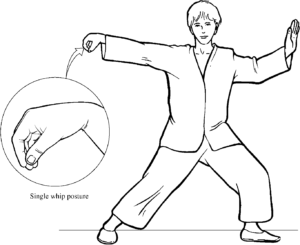One of the advantages of writing this blog is that I can often cover topics that there was not room for in either of my books.
Today I am going to write a little about the “hooked fist”, which in turn leads to some discussion of tai chi’s single whip movement.

Single whip has a number of variations, and this is worth bearing in mind when you view videos of the movement.
Some are variations between different styles of tai chi, while others are different interpretations.
While tai chi is a potent martial art, many of its practitioners only study it for health or meditative purposes and this should be kept in mind when viewing movements.
For purposes of today’s discussion, the “whip” part of the movement will be considered to be with the right hand and the movement has three components I will discuss.

The first “component” is the right hand which comes up to chest level and moves outward, the wrist bending so that the closed hand hangs down. The arm looks a little like you are whipping the rump of a donkey with a riding crop or switch, hence the name of the position.
The shape the hand makes has a number of names. It is sometimes called “Hooked Palm” while the name “Turtle Head” is probably the most descriptive. Some instructors liken it to the “Crane Beak” hand form.
Given the equestrian aspect of the single whip position, the “Horse Foot Palm” name is perhaps most apt.
After the right hand has assumed position, the body turns to the left and the left hand comes up in an open palm. On some variants this is a simple semi-circular movement, while other variants cause the hand to roll over or spiral.
At the same time that the left hand moves the left foot steps forward and outward slightly. I used to find the turn and step unusually difficult until Erle Montaigue told me that you should keep your left elbow above your left knee when making that part.
In English, we tend to call single whip a posture or position, but it is actually a sequence of movements.
When movements from a kata or form are used in combat it is unlikely the whole thing would be used, and used exactly as you would perform it during a kata.
Elements of a kata or form are rather like clay from which you build the thing you need at the moment that you need it. They are not rigid geometric or mathematical constructions, or at least, they are not once your use of them matures.
Most tai chi moves are multifunctional. One instructor may tell you the combat application is one thing, another that it is something else. In reality there may be many more applications.
With that in mind, let us investigate some of the combat applications of the components of single whip.
Single whip is very much the signature move of tai chi.
In movies such as The Matrix you will see single whip used as an opening posture. In reality, it is better reserved until range has been closed with an opponent.
The left palm’s most obvious application is that it is a palm-strike. It is in a good position to hit the chest region or the chin, and the accompanying step forward adds power.
The open palm can also be used to parry, either with the palm or either edge of the hand. The spiralling motions used for the left hand in some varieties of single whip can be used to neutralize a wrist grab.

The horse foot palm is probably most widely understood as a parrying hand form.
It can hook over an enemy’s arm and pull it out or down.
It can parry to either side or upwards.
In his book “Knives, Knife Fighting and Related Hassles: How to Survive a Real Knife Fight” Marc MacYoung describes a tai chi-inspired “Whip Parry” as a defence against knife attack. Since the arm is semi-relaxed, the parry has a very short response time. Marc recommends that you move the wrist and let the hand go along.
Horse foot palm can also be used offensively in a number of ways.
The most obvious is to use it as a hammer-fist strike against targets such as under the arm or the temple.
The hand can also be used as a reverse hammer-fist: swing inward to hit targets such as the back of the head or the shoulder blade.
The hand can also be used to execute a downward glancing punch against certain bony areas of the body.
The hand posture is such that the force of hitting a bony area is dissipated along the arm.
Targets often used for such attacks include the GB 22 point about 3" under the armpit and the area just below the pectoral muscle.
The latter are Liv 14 and GB 24, on the mammary/mid-clavicle line, a couple of ribs down from the muscle in the sixth and seventh intercostal spaces.
These are all potent and potentially very harmful targets which can also be attacked by a hammer-fist from a horse foot palm. Horse foot palm can also suddenly be flipped over to make a back-fist strike to the enemy’s nose!

Both hands can of course be used together. Either hand can parry while the other counter-attacks.
If one hand grabs the wrist, the other can contact the elbow in various ways and apply various varieties of lock. This is another possible application for the spiralling movement of the left hand. Armlocks can be used to unbalance a foe.
The step forward with the left foot also has martial applications. In high level tai chi it is supposed to strike the KD 5 point on the enemy’s foot and drain their qi.
For the less advanced of us, the foot can be positioned to stop an enemy stepping back to regain their balance when the balance is disrupted by hand techniques.